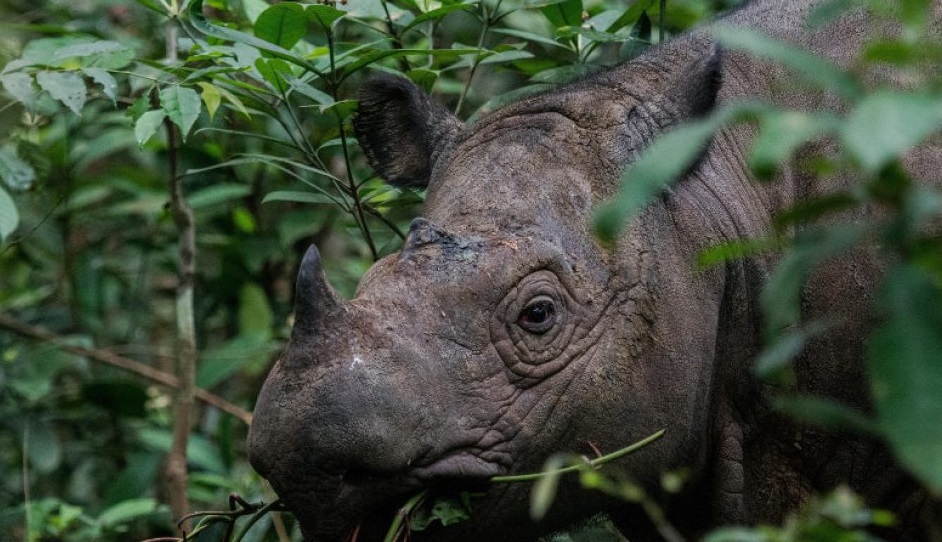Sumatran rhino, also known as the haired rhino (Dicerorhinus sumatrensis), is the only Asian rhino that has two horns. It has the smallest size compared to all subspecies of rhino in the world, although it is still classified as a large mammal.
The largest and perhaps most adequate population for breeding (viable) currently exist in Sumatra, and recently gone extinct in Peninsular Malaysia. Its population in the wild is currently estimated to be less than 300.
These animals are included in the classification of critically endangered species – on the red list of species threatened by the world conservation agency, IUCN. It means that this rhino is almost extinct. Speaking of animals extinction, what are the differences between rare animal and extinct animal?
Unfortunately, it is not only the Sumatran rhino is critically endangered. Javanese rhino is also in critically endangered status. Let’s get closer with Javanese rhino here to get a closer look with Sumatran rhino’s relative.
Now, to have a better understanding of this species let’s get closer look of Sumatran rhino down below.
Characteristics of Sumatran Rhino
- Physical Description
Sumatran rhino, unlike the black rhino from America, is the smallest rhino with a weight ranging from 600-950 kg, height 1-1.5 m, and length 2-3 m. This two-horned rhino has the size of the front horn (anterior) ranging from 25-80 cm while the back horn (posterior) is relatively short and no more than 10 cm. For comparison, check out some amazing facts of black rhino who lives in America.
Sumatran rhino has thin and smooth skin. The reddish-brown skin is almost covered throughout the body by short and stiff hair with a variety of colors that are generally black and white.
The Sumatran rhino has two primary skin folds, one fold behind the front legs and one skin fold around the abdomen. Sumatran rhino feet have a full surface size with each of them having three half-circular nails.
- Behaviors
Sumatran rhino is an explorer and solitary animal. Female Sumatran rhinos are territorial and avoid each other, while female rhinos with young children have smaller home ranges, and female rhinos without children are more exclusive.
The solitary nature of the Sumatran rhino makes living together possible only for male and female rhinos in the breeding season or between the female parent and her children.
The rhino loves to wallow in mud pools to maintain their bodies temperature and protect the skin from insects and parasites. Without wallowing, the skin will be damaged, festering, and inflamed.
Besides, the inflammation will occur in the nails and hair will fall out, it could lead to death. Sumatran rhino has a habit of wallowing in the middle of the day for 2-3 hours. After that, they will wander to find food.
- Habitat
The Sumatran rhino habitat includes lowland swamp forests to hilly forests, although these endangered species generally love forests with very dense vegetation. Sumatran rhino diet is fruit (especially wild mangoes and ficus fruits), leaves, small branches, and bark.
They prefer the lowlands, especially in secondary forests, where there are many low-growing food sources. Sumatran rhino lives in nature in small groups
- Population
In 2019 there are only less than 70 Sumatran rhinos left. In Sumatra, this population scatters in Gunung Leuser National Park, Bukit Barisan Selatan National Park, and Way Kambas National Park. Meanwhile, in Kerinci Seblat, no traces have been found since 2011. In East Kalimantan, it is estimated that there are less than 15 individuals.
- Status
The current status of Sumatran rhino is critically endangered. The existence of Sumatran rhino is hard to detect because they generally live in lowland swamp forests to the hills. Sumatran rhino population is increasingly eroded due to several factors.
Among them are the difficulties in reproduction, disturbance of habitat, and its high sensitivity to interact with other domestic animals. Besides, animal hunting, forest encroachment, illegal logging, and forest wildfire can still be another threat to this endangered species.
How to Save Sumatran Rhino
The Government of Indonesia and Sumatran Rhino Rescue, an alliance consisting of leading international conservation institutions, have succeeded in rescuing and relocating endangered Sumatran rhinos in a healthy condition.
Its solitary nature makes it difficult to breed because it is hard to meet with their partners. The Sumatran rhino was rescued to a safe place in Kalimantan (Borneo) with support from local partners.
This rescue operation is the main activity of the breeding conservation program which aims to save this species from extinction and to increase the Sumatran rhino population.
The rescue of the Sumatran rhino is also related to the efforts of preventing the rhino’s horn smuggling abroad through back market. The number of rhinos is increasingly threatened by the hunt for horns that are traded on the black market.
In fact, now rhino horn can be created from horsehair without having to take it from a rhino which is now almost extinct. How can rhino horn will be created by horse hair? It’s amazing, isn’t it?
After years of hunting and habitat loss, the biggest threat today is the small population and the spread of population in various regions. Due to its isolated population, it is not very easy to find a partner.
The struggle of breeding the Sumatran rhino also has a high risk due to a long period of isolation. In their habitat that spread over two large islands in Indonesia, the hope for the survived-rhinos depends on the ability of conservationists to find and move them safely to individual facilities designed for their care.
Of course, we can help to save the Sumatran rhino too. These are the steps we need to save animals before they are extinct.

